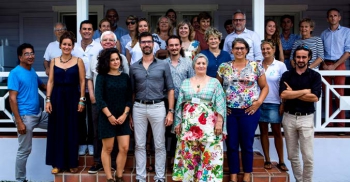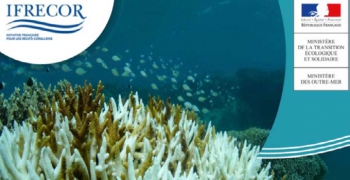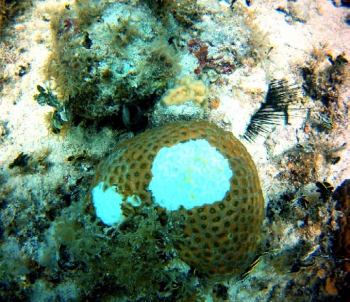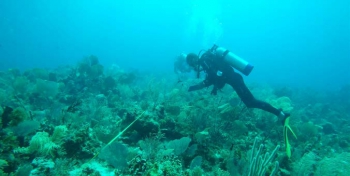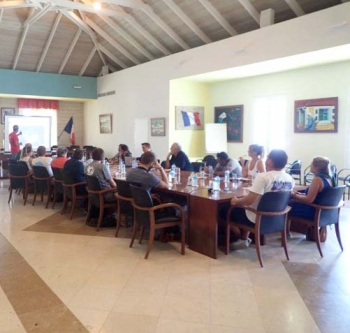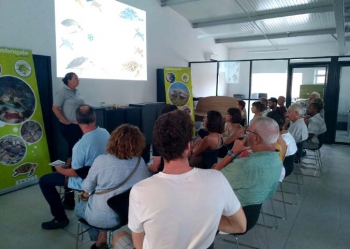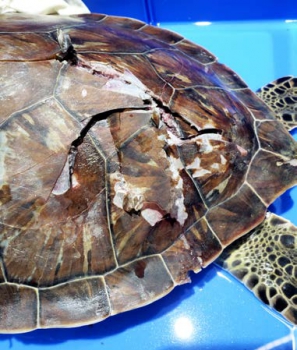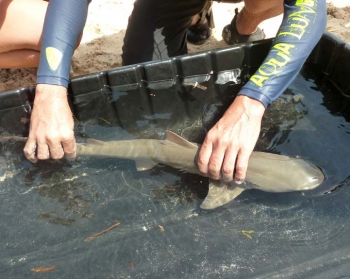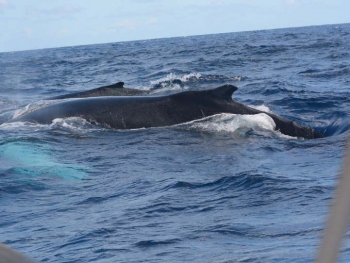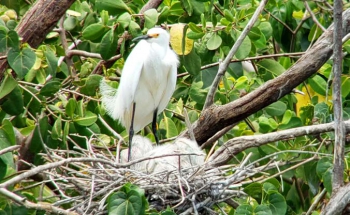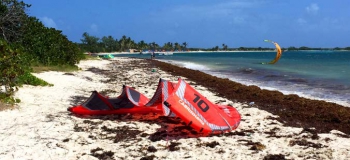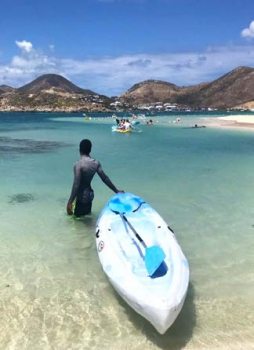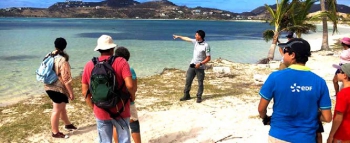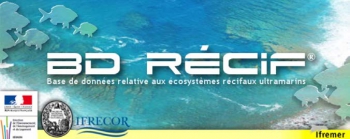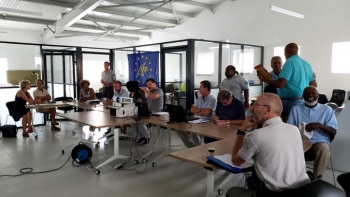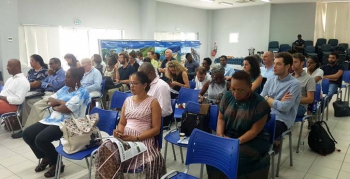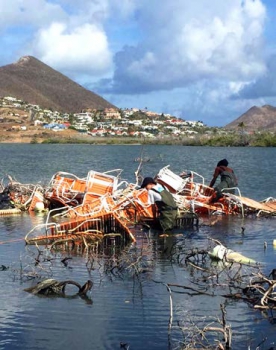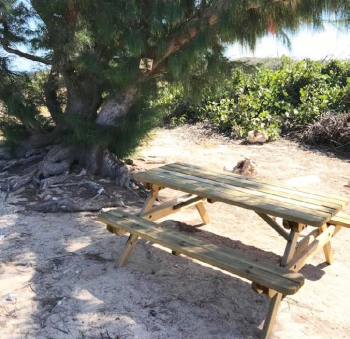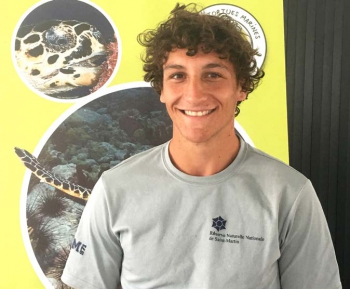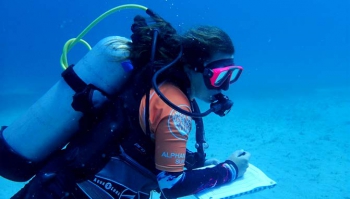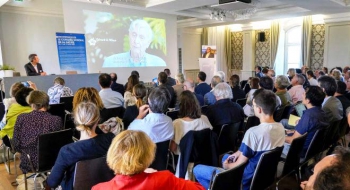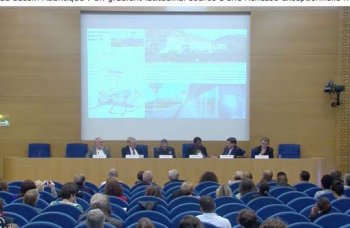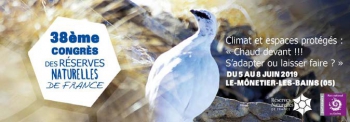On June 3-7, the Réserve Naturelle hosted the 35 participants of the IFRECOR national committee (French Initiative For Coral Reefs). Created in 1999 and led by the environmental and overseas ministers, IFRECOR set out to create a policy that promotes the preservation and management of coral reefs. Saint Martin was selected to organize this important biennial event, and to showcase the island almost two years after Irma. After a first meeting at the CCISM, the working meetings took place at the Esmeralda Hotel, where the committee was staying. On the agenda: activities created by all of the local committees as well as the Réserve Naturelle of Saint Martin —as the island does not have its own IFRECOR committee at the moment— to discuss coral conservation, post-Irma shipwrecks, and a post-hurricane report about the island. As coral reefs and related flora, such as the underwater plant beds and mangroves, are threatened throughout all French overseas areas, each participant presented the current situation on their island, in each of the three oceans. At the same time, scientific experts discussed the results of their work and the actions taken
Journal-35
Journal-35
To promote the conservation of the coral reefs and related species
Alphanova presented a check for 12,000€ to the Réserve Naturelle, as part of its 1% program for coral. This donation was made at KKO restaurant on Monday, June 3, during a cocktail party sponsored by Alphanova for the inauguration of the IFRECOR committee meeting in Saint Martin. As we announced in our last issue, this company has invested in organic suntan products that respect the environment, and has signed a sponsorship agreement with the Réserve Naturelle of Saint Martin, to which they donate 1% of their worldwide sales. In exchange, the Réserve has promised to promote the restoration of coral in its marine zones, especially by planting new cuttings. In early June, a group from Alphanova Sun was able to experience the marine milieu of the Réserve and appreciate the work done by their staff, accompanied by Julien Chalifour, as well as Camille Sanchez and Colette Buisson, the two student interns at the Réserve. They visited the artificial habitats, which since October 2018 have become a refuge for coral cuttings. Hundreds of cuttings were recovered from the nurseries that were weakened by Irma and were able to be fragmented to encourage their multiplication. At the same time, 200 of these little sprouts were added to the BioHab2 site off the coast of Tintamare. To date, the Réserve has limited this activity to these artificial sites, as it is necessary to have special permission from the government to replant the coral at natural sites, since the two types of coral —elkhorn coral (Acropora palmata) and staghorn coral (Acropora cervicornis)— have been considered protected species in the French Antilles since 2017.
As if the coral has not suffered enough from higher temperatures due to climate change, the past year has also seen a new disease that kills coral within just a few days. Very present in Florida and the Gulf of Mexico, this disease baptized SCTL —Stony Coral Tissue Loss— was first observed on the Dutch side earlier this year and is possibly transported and spread via the ballast of cruise ships and cargo ships. As its name indicates, this disease is characterized by a rapid necrosis of living tissue on the surface of massive coral —brain coral, pillar coral— which die in the space of a week without possibility of recuperation. The presence of this disease was confirmed at Rocher Créole and Tintamare and is of a bacterial nature. The Réserve Naturelle invites all divers to report any new sightings as well as take all necessary precautions to avoid spreading the disease, for example by disinfecting all dive gear: rinse in fresh water with chlorine and dry in the sun.
How is the overall health of the reefs and underwater plant beds recovering since hurricane Irma? A question that Emma Bernardin, a third-year student at Jean- François Champollion University in France, tried to answer. She has been working on extrapolating the data collected during underwater dives led by the Réserve in 2018, within and outside of protected sites. For the plant beds, the feeling remains that they were only lightly impacted, with the station outside of the Réserve in Grand Case showing the most damage in terms of the density of the plants and eutrophication, since the water was over enriched with organic material. Concerning the reefs, a reduction in the overall coverage of the coral was observed especially outside of Réserve and in proximity to Orient Bay, where the reef is less than 10% covered with living coral. Irma also provided these stations with a major reduction in macro algae and algal turf.
Formerly included in the local committee for IFRECOR (French Initiative For Coral Reefs) in Guadeloupe, Saint Barth has had its own local committee since October 2018. This group met for the first time on April 12, 2019 in Gustavia, under the aegis of the Territorial Environmental Agency (ATE). Julien Chalifour, director of the scientific division of Réserve Naturelle of Saint Martin, participated in this first meeting, at which time the ATE and the Collectivité of Saint Barth formalized their partnership with IFRECOR and the French Agency for Biodiversity (AFB), while bringing together all those concerned on the island, in order to establish study groups in conjunction with scientific experts. At the end of these technical workshops, the challenges of preservation of the coral reef and marine plant beds were identified as the main issues and given priority, in order to determine the best actions to get started and ensure their conservation.
To promote the conservation of the sea turtle population
A group of eco-volunteers turned out in big numbers this year, with no less than 50 people regularly patrolling the beaches in order to find tracks left by the marine turtles that come ashore to lay their eggs. By mid-June, three observations had been noted. A first informational meeting was held on April 19 at L’Etage restaurant in Hope Estate, and a second on June 21 at the Réserve. For Julien Chalifour, director of the Réserve’s scientific division, the return of these activities, in spite of the scars left by Irma, as well as the recent invasion of Sargasso seaweed, is very encouraging, but he points out the importance of maintaining the quality and tranquility of the areas around the sites where the eggs are laid.
Seven marine turtles have died since January 1, the majority of which were involved in a collision with a boat or a jet ski. And that number only concerns those turtles found on the shore and reported to the Réserve Naturelle. How many others have been victims of a collision at sea that went unnoticed? It takes 25 years for these turtles to be able to reproduce, and only one in a thousand actually reach that age. Sadly these accidents involve mature turtles as well as juveniles that have not yet had the chance to reproduce.
To promote the conservation of nurseries for sharks and rays
Deux membres du réseau REGUAR d’étude et de conservation des requins et des raies en Guadeloupe ont été accueillis par le Pôle scientifique de la Réserve naturelle fin avril 2019. Cette rencontre a été l’occasion de renouveler les observations initiées depuis plusieurs années à Saint-Martin afin d’identifier des zones de nurserie et constater si des juvéniles étaient présents dans ces espaces de faible profondeur et proches du rivage, à l’abri de leurs prédateurs.
To maintain or improve local conditions for marine mammal populations
The Réserve Naturelle of Saint Martin naturally took part in a meeting of 70 specialists from protected marine areas, as well as marine mammal experts in Gosier, Guadeloupe, on May 9-10, 2019. Agoa and Cari’Mam — Caribbean Marine Mammals Preservation— the network for the protection of marine mammals in the Caribbean, organized the meeting. The French islands and Guyana were present, as well as the Dutch islands, Anguilla, The Bahamas, Barbados, Bermuda, Cuba, Dominica, Haiti, Jamaica, The Turks & Caicos, and the United States. Various ateliers allowed the participants to exchange ideas about protected marine areas and their management, public awareness campaigns, beaching of marine mammals, and the sustainability of whale watching. Saint Martin, represented by Nicolas Maslach, director of the Réserve Naturelle, and Michel Vély, president of Megaptera, as well as Bulent Gulay, president of Métimer, commanded attention as they presented the latest Megara campaign. This campaign comprised deploying six beacon tags and following the humpback whales on their journey toward North America and Europe, as well as taking eight skin samples, a dozen photos of tail fins, and recording numerous songs by the male whales. The Agoa sanctuary, which offers protection for marine mammals, covers the entire economic zone of the French Antilles, or 143,256 square kilometers.
To maintain or improve local conditions for nesting bird populations
ZICO: Zones of Importance for Bird Conservation. On April 1, 2019, to help define these high-priority sites, Julien Chalifour and Aude Berger, from the scientific division of the Réserve Naturelle, hosted a mission from the League For The Protection of Birds (LPO), as part of the European BIODIV’OM LIFE project. The goal was to initiate the process of defining ZICO for Saint Martin, which will be based on existing data and the acquisition of additional knowledge in order to delineate sites that represent major challenges for protected species, such as the little tern or blue egret. Once identified, a list of these high-priority zones will be presented to ornithology experts for validation, and certain zones will be added to the ZICO world list. Being included on the list would create new opportunities for the recruitment of experts and the funding of activities to promote the protection of birds on our island. This project comprises the Réserve Naturelle of Saint Martin, as well as five additional structures in French Guyana, Martinique, Reunion, and Mayotte. The LPO, coordinator of the BIODIV’OM LIFE project, serves as the liaison between the European Union and the six participating partners.
Keeping an eye on the regulations and the level of human activities compatible with the goals of La Réserve
Since January 1, 2019, the police of Réserve Naturelle have completed 153 patrols on land, of which 141 were in keeping with the regulations, as were 35 of the 39 patrols done at sea. The only reprimand was addressed to the president of the Tropikite association on April 14, when a group of kite surfers assembled on the beach in Galion, in spite of an order from the prefect prohibiting the sport at this protected site. A first such assembly was given the same warning, and the person incriminated was interviewed by the gendarmerie, which sent the report to the prosecutor’s office. Please note that kite surfing is authorized throughout the Réserve Naturelle except over the waters of Galion bay, which is a site set aside for family activities, swimming, and nautical activities that do not present a danger for those using the site.
Ensuring environmental communication, awareness, and education
A group of 20 kids from Milton Peters College, a middle school on the Dutch side, accompanied by their guests from The Netherlands, were able to explore the terrestrial and marine flora and fauna on the small island of Pinel, with the help of the Réserve Naturelle. On foot, or outfitted with a mask, snorkel, and fins, they were made aware of the problems caused by Sargasso seaweed, the decline of the water quality along the coastline, and invasive species, as well as free services provided by nature for the benefit of mankind such as the production of fish, protection against the elements, and water purification. These activities seem even more important to the students in the context of climate change that directly impacts our islands.
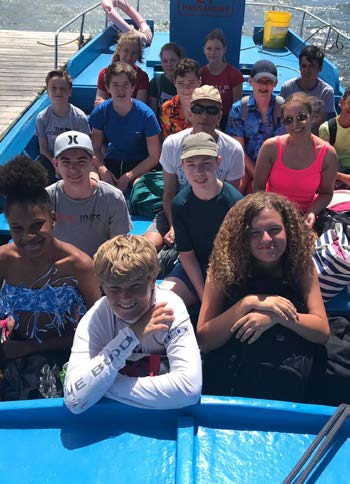
When the staff of the electric company, EDF Archipel Guadeloupe asked, the Réserve Naturelle organized an excursion in the Galion mangrove. This event, which took place on May 25 as part of the Fête de la Nature 2019, served to promote awareness of the diversity of the flora and fauna that exists in this often under-estimated milieu. This marshy coastal forest helps stabilize the land closest to the sea, purify runoff water, produce a large number of fish, crustaceans, and birds, and it represents the last rampart against bad weather conditions and the swell. The participants at the event were able to observe fish, crabs, and wading birds, as well as contribute to the task of collecting trash that is sadly left along the borders of this protected natural site. Hoping that the participants will now be ambassadors, and carry the message of awareness for a better understanding of the mangrove, an important asset that is part of the island’s natural heritage. The Réserve Naturelle is also pleased with the increased popularity of bird watching and the growing number of visitors attracted by the rich diversity of birdlife in Saint Martin.
Optimizing management means
What happens to all the data stored in our computers? Where will it be in 20 years? Or beyond? A question that IFRECOR and the French government have tried to answer in terms of coral reefs and sea plant beds in France. Presented in Martinique in 2017 to the administrators of protected marine sites in the region, including Julien Chalifour, this tool created by IFREMER allows all data collected by each site to be stored, as well as exchanged for a better sharing and interpretation of knowledge: and all on a national level. The AFB organized a second technical training day on the storing of this data on May 15, 2019 in Guadeloupe, and to which the scientific representatives of the Réserve Naturelle —Julien Chalifour and Aude Berger— were invited. This meeting was also an opportunity for the two scientists to see how the process has advanced and to meet a large number of partners collaborating with the Réserve on the conservation of marine ecosystems. These partners include government services, administrators, consultants, associations...
The advisory board for the Réserve Naturelle met in the Reserve’s new offices at Hope Estate, on June 26, 2019. The meeting was run for the first time by prefect Sylvie Feucher, who opened the proceedings by drawing attention to the fact that the island’s biodiversity, and especially the salt ponds, have suffered greatly. This annual meeting also gave the Réserve Naturelle the chance to present and validate its 2018 budget as well as its provisional budget for 2019. Staff from each of the divisions of the Réserve presented their future and current projects. The prefect suggested that the advisory board meet twice per year, once in January and a second time in June.
Under the auspices of the Conservatoire du Littoral, the Council of French Shores in America (CRFA) held its plenary session in Saint Martin this year on June 18-20 at the CCISM. The two days of meetings were dedicated to a review of activities completed during the year, as well as a look at future projects, with an eye to best preserving the coastlines in French Guyana, Guadeloupe, Martinique, Saint Barth, and Saint Martin. Solicited to speak on behalf of the Réserve Naturelle, Nicolas Maslach stressed the importance of strengthening the partnerships with those that defend the interests of the Réserve and its regulations. He also noted that with a spirit of impartiality and goodwill, the Réserve serves as a tool that is put to the service of Saint Martin and its population.
The entire staff of the Réserve Naturelle was mobilized to help fish 256 chaise lounges out of the Salines d’Orient pond, where they had been carried from Club Orient by the winds of Irma. It took a full day to get the job done, with the efficient help of youngsters from the ACED. The rental of a telescopic forklift helped with the task, before the destroyed chairs could be transported to the Grandes Cayes eco-site.
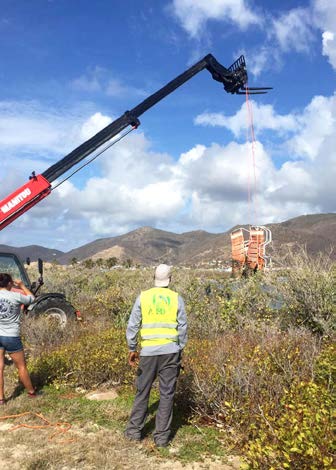
Destroyed by hurricane Irma, various items put in place by the Réserve Naturelle are progressively being replaced and made available for use. On Tintamare, where only three wooden tables remained, two new ones are now ready for those who want to picnic on the island. Others will be happy to see that three identical tables have been installed on Pinel, two between the restaurants and the third to the right of the embarcadero, in the shadow of a pretty catalpa tree. The five pieces of furniture were made by students in the carpentry and woodworking atelier at the polyvalent high school, as were the previous tables. A huge thanks to these kids on behalf of the Réserve Naturelle!
Titouan Pageaud, an 18 year-old studying physical education at the university in Nice, lived more than 10 years in Saint Martin. Nostalgic for his island, he is pleased to be working during his summer vacation as a guard for the Réserve Naturelle. «When you grow up here, you realize the importance of nature, and it makes me happy to play a useful role for the environment of Saint Martin,» he told us.
Understanding and continual study of the natural heritage
Colette Buisson, an intern at the Réserve Naturelle from April 15 through August 30, is working on the deployment and study of the colonization of artificial marine habitats as part of the BioHab2 project. A student at the Institut Intechmer of Cherbourg (CNAM), she has spent the past three years studying as a technical engineer for the marine environment. To complete her project for the Réserve, she has retrieved all of the data relating to BioHab2, which is installed onsite at Tintamare, and she will participate in the placement of a second artificial habitat near Anse Marcel, within the perimeter of the Réserve Naturelle. A certified diver, she also participates in other scientific outings for the reserve —observing coral, plant beds, birds— and will submit her report at the end of her internship, and defend it at Intechmer in September. Her experience in Saint Martin allows her to acquire solid professional experience in various areas in the management of vegetal and animal populations.
Reinforcing local and regional commitment to the Réserve
Nicolas Maslach, director of the Réserve Naturelle of Saint Martin was among the 300 representatives including experts, organizations, and partners at the meeting for the French committee of the UICN (International Union For The Conservation of Nature), which was held on June 12, 2019 in Marseille. The goal of this meeting was to prepare for the World Nature Congress of the UICN, scheduled for June 11-19, 2020 in Marseille. This event included the discussion of 28 recommendations concerning some of the biggest challenges in terms of the conservation of nature on a worldwide basis. The Réserve Naturelle is going to present its candidature for the UICN’s Green List, as it did in 2017, sadly right before hurricane Irma hit the island. This Green List includes 46 sites, 14 of which are in mainland and overseas France. The UICN’s Green List of Protected Areas sets the global standard for best practices for conservation by zone. It includes a system of certification for protected areas (national parks, worldwide natural heritage sites, areas protected by their communities, marine parks, etc.) that are properly managed and promote a positive approach to conservation.
Invited to the Senate by senator Michel Magras, president of the overseas commission, and by the French Agency for Biodiversity, Nicolas Maslach actively participated in a symposium on June 6, 2019, on the biodiversity of the Atlantic basin, which was also attended by Annick Girardin, French Overseas Minister. This symposium was part of a cycle on overseas biodiversity, intended to make politicians aware of the assets and weaknesses of the natural heritage in these far-off islands, as well as the stakes, challenges, and perspectives to be considered. The director of the Réserve Naturelle spoke on two subjects, each illustrated by a video. The first was a look at BioHab2, the artificial habitat submerged in the waters of the Réserve and constituted of post-Irma debris, decontaminated if necessary and recycled. Today, these innovative structures allow fish and crustaceans to take refuge and improve their conditions for survival. The second presentation by Nicolas Maslach addressed the Caribbean Institute for Insular Biodiversity. The video for this presentation can be found online:
Franck Roncuzzi, director of the technical division and nature police, accompanied by Vincent Oliva, a guard at the Réserve Naturelle in charge of educational and environmental missions, participated at the 38th summit for Réserves Naturelles in France, June 5-8, 2019 at Le-Mônetier-les-Bains, in the Hautes-Alpes. They found themselves amongst 350 other administrators of nature preserves. Respectively speaking about the police and education divisions as part of the overseas commission, and have been reappointed for their missions.

